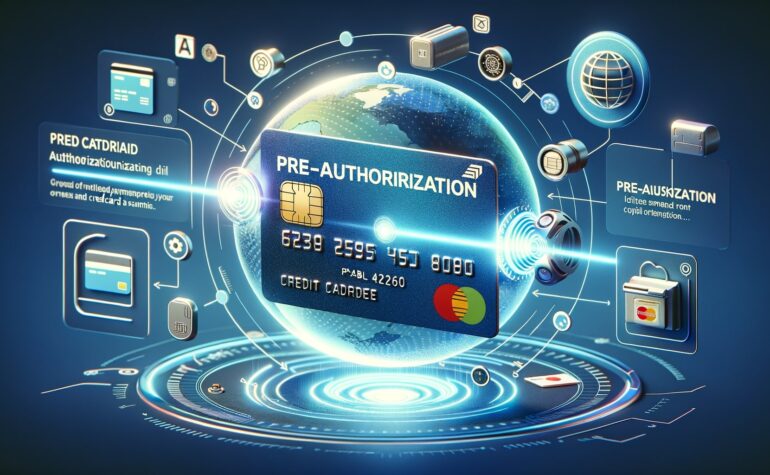Best Credit Card Processing Solutions Tailored for Every Industry

By admin November 16, 2024
In today’s digital age, credit cards have become an essential tool for making purchases and managing finances. However, there are certain instances where a simple swipe or tap of your credit card may not be enough to complete a transaction. This is where pre-authorization comes into play. Pre-authorization is a process that allows merchants to verify the availability of funds on a credit card before the actual purchase is made.
In this comprehensive guide, we will delve into the intricacies of pre-authorization on credit cards, exploring how it works, its purpose, the step-by-step process, common scenarios where it is used, the benefits and drawbacks, and tips for managing pre-authorizations on your credit card.
How Does Pre-Authorization Work?
Pre-authorization is a two-step process that involves obtaining approval from the credit card issuer before the actual purchase is made. When a merchant initiates a pre-authorization, they send a request to the credit card issuer to verify the availability of funds on the card. The issuer then places a temporary hold on the funds, reserving them for the merchant. This hold ensures that the funds will be available when the transaction is completed.
During the pre-authorization process, the merchant typically obtains the cardholder’s consent to place a hold on the funds. This can be done by swiping the card, entering the card details manually, or using contactless payment methods such as NFC or mobile wallets. The merchant then sends the pre-authorization request to the credit card issuer, who either approves or declines the request based on the available credit limit and other factors.
Understanding the Purpose of Pre-Authorization

The primary purpose of pre-authorization is to protect both the merchant and the cardholder. For merchants, pre-authorization ensures that they will be paid for the goods or services they provide. By verifying the availability of funds before completing the transaction, merchants can minimize the risk of accepting payments from customers with insufficient funds or fraudulent cards.
On the other hand, pre-authorization also benefits cardholders by providing them with a sense of security. By placing a temporary hold on the funds, cardholders can be confident that the merchant will not overcharge them or make unauthorized transactions. Pre-authorization also allows cardholders to manage their available credit limit more effectively, as the reserved funds are deducted from the available balance.
The Process of Pre-Authorization: Step-by-Step

The pre-authorization process involves several steps, starting from the initiation of the request to the final settlement of the transaction. Let’s take a closer look at each step:
- Initiation: The merchant initiates the pre-authorization request by obtaining the cardholder’s consent and sending the request to the credit card issuer.
- Verification: The credit card issuer receives the pre-authorization request and verifies the availability of funds on the card. This involves checking the cardholder’s credit limit, account balance, and any other relevant factors.
- Approval or Decline: Based on the verification process, the credit card issuer either approves or declines the pre-authorization request. If approved, the issuer places a temporary hold on the funds, reserving them for the merchant.
- Hold Period: The funds remain on hold for a specified period, typically ranging from a few hours to several days, depending on the merchant’s policies and the type of transaction.
- Completion of Transaction: Once the hold period expires or the transaction is completed, the merchant requests the final settlement from the credit card issuer. At this stage, the actual purchase amount is deducted from the held funds, and the remaining balance is released back to the cardholder.
Common Scenarios Where Pre-Authorization is Used
Pre-authorization is commonly used in various industries and scenarios where there is a need to verify the availability of funds before providing goods or services. Some of the most common scenarios where pre-authorization is used include:
- Hotels and Rental Cars: When booking a hotel room or renting a car, pre-authorization is often required to cover potential additional charges such as room service, mini-bar expenses, or damages to the rental vehicle.
- Gas Stations: Gas stations commonly use pre-authorization to ensure that customers have sufficient funds to cover the cost of fuel. The pre-authorization amount is typically set to a predetermined maximum limit, such as $100, to account for different fuel purchase amounts.
- Restaurants: In upscale restaurants or establishments that offer dine-in services, pre-authorization may be used to secure a table reservation or cover potential additional charges such as tips or drinks.
- Online Shopping: E-commerce websites often use pre-authorization to verify the validity of credit cards and ensure that customers have sufficient funds to complete the purchase. The pre-authorization amount is usually the total cost of the order.
- Car Rentals and Hotel Deposits: When renting a car or booking a hotel room, a pre-authorization hold is often placed on the credit card to cover any potential damages or incidentals. This hold is released once the car is returned or the hotel stay is completed without any issues.
Benefits and Drawbacks of Pre-Authorization

Pre-authorization offers several benefits for both merchants and cardholders. However, it also has some drawbacks that need to be considered. Let’s explore the advantages and disadvantages of pre-authorization:
Benefits of Pre-Authorization
- Reduced Risk of Fraud: Pre-authorization helps merchants minimize the risk of accepting payments from customers with fraudulent or stolen credit cards. By verifying the availability of funds before completing the transaction, merchants can detect potential red flags and prevent unauthorized purchases.
- Increased Security for Cardholders: Pre-authorization provides cardholders with a sense of security, knowing that their funds are protected from unauthorized transactions or overcharges. It also allows them to manage their available credit limit more effectively.
- Efficient Payment Processing: Pre-authorization streamlines the payment process for both merchants and cardholders. By reserving the funds in advance, merchants can ensure a smooth and hassle-free transaction, while cardholders can enjoy a seamless checkout experience.
- Flexibility for Merchants: Pre-authorization gives merchants the flexibility to hold funds for a specified period, allowing them to secure goods or services for customers without immediate payment. This is particularly useful in industries such as hotels, car rentals, and online shopping, where reservations or bookings are made in advance.
Drawbacks of Pre-Authorization
- Temporary Hold on Funds: One of the main drawbacks of pre-authorization is that it places a temporary hold on the funds, reducing the available credit limit for cardholders. This can be inconvenient, especially if the hold amount is significant or if the cardholder has a low credit limit.
- Potential Overcharges: In some cases, merchants may accidentally or intentionally overcharge customers, leading to disputes and inconvenience. While pre-authorization helps mitigate this risk, there is still a possibility of errors or fraudulent practices.
- Delayed Release of Funds: Depending on the merchant’s policies and the credit card issuer’s processing time, the release of funds from a pre-authorization hold may be delayed. This can be frustrating for cardholders who need immediate access to their funds.
Pre-Authorization vs. Regular Credit Card Transactions

It is important to understand the difference between pre-authorization and regular credit card transactions. While both involve the use of credit cards for making purchases, there are distinct characteristics that set them apart.
Regular credit card transactions involve the immediate transfer of funds from the cardholder’s account to the merchant’s account. When a card is swiped or tapped, the transaction is processed in real-time, and the funds are deducted from the available credit limit. This type of transaction is commonly used for everyday purchases, such as groceries, clothing, or dining out.
On the other hand, pre-authorization is a two-step process that involves obtaining approval from the credit card issuer before the actual purchase is made. The funds are placed on hold, reserving them for the merchant, but the transaction is not completed until the hold period expires or the final settlement is requested. Pre-authorization is typically used in scenarios where there is a need to verify the availability of funds in advance, such as hotel bookings, car rentals, or online shopping.
Tips for Managing Pre-Authorizations on Your Credit Card
Managing pre-authorizations on your credit card can help you stay on top of your finances and avoid any potential issues. Here are some tips to consider:
- Monitor Your Credit Card Statements: Regularly review your credit card statements to ensure that all pre-authorization holds are released and that there are no unauthorized charges. If you notice any discrepancies, contact your credit card issuer immediately.
- Keep Track of Pre-Authorization Holds: Make a note of any pre-authorization holds on your credit card, including the merchant’s name, the hold amount, and the expiration date. This will help you keep track of your available credit limit and avoid any surprises.
- Plan Your Budget Accordingly: Take into account any pre-authorization holds when planning your budget. If you have a low credit limit or anticipate multiple pre-authorizations, it may be wise to allocate your funds accordingly to avoid exceeding your available credit.
- Communicate with Merchants: If you have any concerns or questions about pre-authorization holds, don’t hesitate to reach out to the merchant. They should be able to provide you with information about their policies and the release of funds.
- Consider Using a Separate Credit Card: If you frequently encounter pre-authorization holds or prefer to keep your available credit limit unaffected, consider using a separate credit card specifically for pre-authorization purposes. This way, you can manage your funds more effectively and minimize any potential disruptions.
Frequently Asked Questions about Pre-Authorization
Q1. What happens if a pre-authorization hold expires?
If a pre-authorization hold expires, the funds are released back to the cardholder’s account. However, the exact timing may vary depending on the credit card issuer and the merchant’s policies.
Q2. Can a pre-authorization hold be canceled?
In most cases, pre-authorization holds cannot be canceled by the cardholder. The hold is typically released automatically after a certain period or when the transaction is completed.
Q3. Can a pre-authorization hold be higher than the final transaction amount?
Yes, a pre-authorization hold can be higher than the final transaction amount, especially in industries where additional charges or potential damages may occur. However, the final transaction amount should not exceed the pre-authorized amount.
Q4. Can a pre-authorization hold be lower than the final transaction amount?
In some cases, a pre-authorization hold may be lower than the final transaction amount. This can happen when the merchant wants to verify the card’s validity but does not need to reserve the full transaction amount.
Q5. Can a pre-authorization hold be extended?
Pre-authorization holds are typically released automatically after a predetermined period. However, in some cases, the hold may be extended if the transaction is not completed within the initial timeframe.
Conclusion
Pre-authorization on credit cards is a valuable tool that benefits both merchants and cardholders. By verifying the availability of funds before completing a transaction, pre-authorization helps minimize the risk of fraud, provides security for cardholders, and streamlines the payment process.
While there are some drawbacks, such as temporary holds on funds and potential delays in releasing them, managing pre-authorizations effectively can help cardholders stay in control of their finances. By monitoring credit card statements, keeping track of pre-authorization holds, planning budgets accordingly, and communicating with merchants, cardholders can navigate the world of pre-authorization with confidence and peace of mind.
